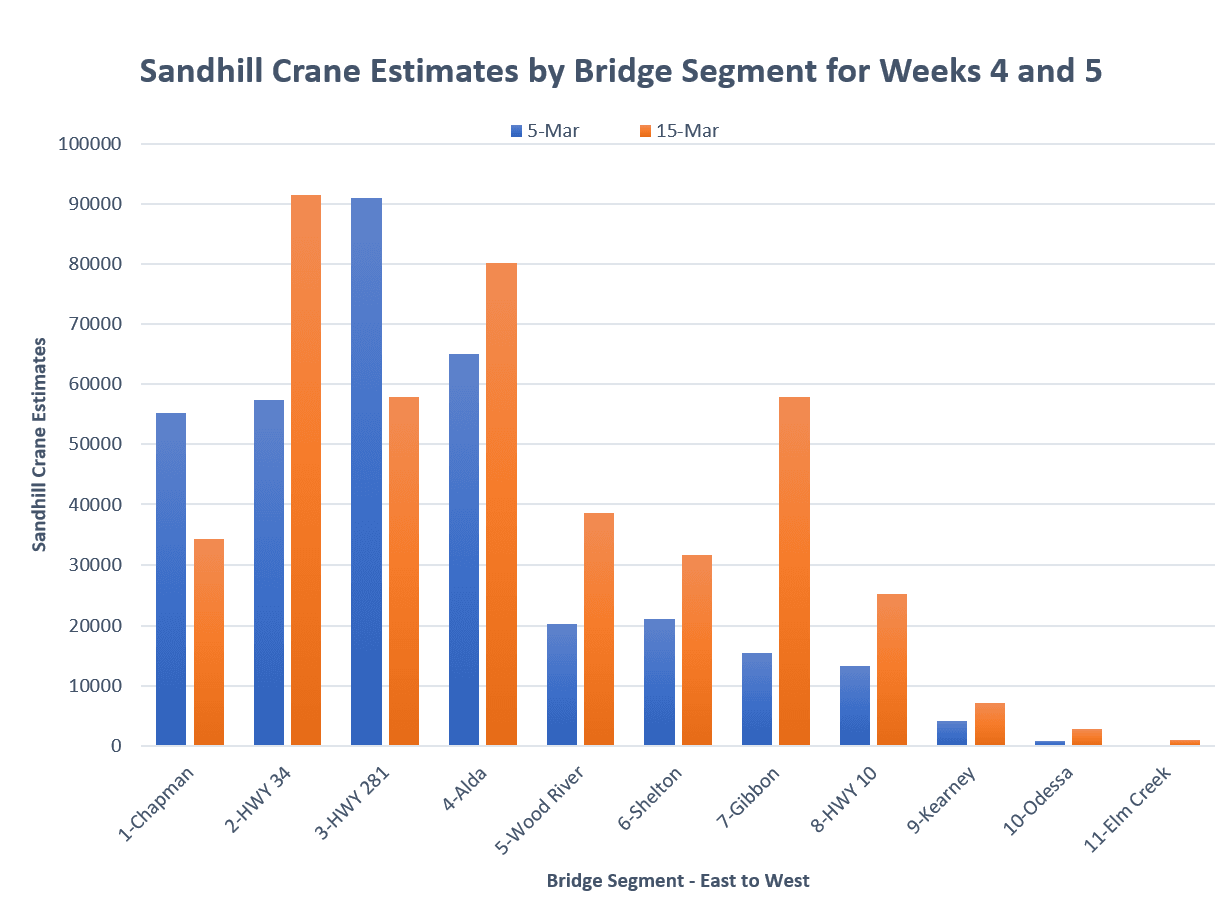
We reached halfway! Week 5 of crane season! On March 15th we estimated there are at least 429,000 +/- 81,000 Sandhill Cranes within the Central Platte River Valley (CPRV) between Chapman and Overton, NE. This is about a 25% increase from the numbers we saw last week. We saw large increases to the west and a fairly stable or slightly increasing population to the east. This is very typical of this time of year. Lesser Sandhill Cranes are arriving in the west as Greater Sandhill Cranes are likely nearing the end of their stay in the CPRV. This, of course, is an oversimplification of the dynamics between lessers and greaters and where and when they migrate and stopover. Reality is more nuanced and better described in full scientific publications such as Caven et al. 2019 “Temporospatial shifts in Sandhill Crane staging in the Central Platte River Valley in response to climatic variation and habitat change” and Krapu et al. 2014 “Spring migration ecology of the mid‐continent Sandhill Crane population with an emphasis on use of the Central Platte River Valley, Nebraska” (https://cranetrust.org/who-we-are/what-we-do/conservation/research/).
The graph shows the estimated number of cranes in each bridge segment, comparing week 4 (March 5th, blue) with week 5 (March 15th, orange). Numbers greatly increased in each segment west of Wood River. Looking at segments 1-4 shows that numbers didn’t change overall too dramatically but rather it looks like cranes shifted in what segment they were roosting. This especially makes sense when looking at the river gauge data (https://waterdata.usgs.gov/monitoring-location/06770500/#parameterCode=00060&period=P7D&showMedian=false). Last week around March 5th, flows at the Grand Island gauge were much lower, around 700-900 cfs. This week they were up to around 1400-1700 cfs. This would ultimately change where cranes were able to roost as they prefer to roost in shallow waters where they don’t risk needing to take a swim. This is part of the beauty of the Platte River’s braided channels. There is variety in the channel width and depth to allow for cranes to adapt to changes within the amount of water flowing downstream. This also speaks to why having large expanses of healthy channel is a necessity for the increasing population of Sandhill and Whooping Cranes and their future success.
As a reminder these estimates are related to the minimum number of cranes estimated in the CPRV. So, we can be fairly confident there are AT LEAST 429,000 +/- 81,000 cranes in the area. The error estimate (or +/-) comes from how consistent my estimates were in relation to reality (determined from photo subplots). Winds during the survey caused the plane to be angled in a way that reduced how far ahead I was able to see upstream and made it more difficult to slow down to the preferred speed for counting large roosts of cranes. Both of these factors lead to higher variability in my roost size estimates.
We have also had reports of large numbers of Sandhill Cranes stopping over in the North Platte area in the recent days. While a large majority of the Midcontinental Population (MCP) of Sandhill Cranes stopover in the CPRV, based off peak numbers in 2018 and 2019, around 17% of the MCP stopover in the North Platte River Valley (NPRV, Caven 2023). Using this week’s estimate and past years’ trends, we could roughly estimate 59,000 – 87,000 in the NPRV. However, this is speculation as we have not been able to survey the NPRV in recent years.
We expect this week to be peak as we have been seeing activity suggesting some cranes are getting ready to head north. However, winds for this week are forecasted to be mostly from the north, possibly slowing the rate of cranes leaving and/or arriving to the CPRV. Leave it to the cranes to keep us all in suspense. However, hundreds of thousands of cranes will still be in the area for the next half of crane season!
Till next week!
References
Caven, A.J. 2023. An Updated Minimum Estimate of the Global Sandhill Crane Population. SSRN: Platte River Natural Resource Reports eJournal 2:1-14.
Caven, A.J., E.M. Brinley Buckley, K.C. King, J.D. Wiese, D.M. Baasch, G.D. Wright, M.J. Harner, A.T. Pearse, M. Rabbe, D.M. Varner, B. Krohn, N. Arcilla, K.D. Schroeder, K.F. Dinan. 2019. Temporospatial shifts in Sandhill Crane staging in the Central Platte River Valley in response to climatic variation and habitat change. Monographs of the Western North American Naturalist 11(1):33-76.
Krapu, G.L., D.A. Brandt, P.J Kinzel, and A.T. Pearse. 2014. Spring migration ecology of the mid‐continent Sandhill Crane population with an emphasis on use of the Central Platte River Valley, Nebraska. Wildlife Monographs 189(1):1-41.